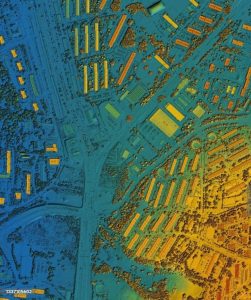Usage Of GEOFS In Aviation Industry
 The aviation industry is one of the most dynamic and complex sectors globally, characterized by a constant flow of data generated from various sources, including flight operations, maintenance, and passenger services. With the increasing reliance on geospatial data, the introduction of the Geospatial Open File System is revolutionising how aviation organisations manage and utilise this data. In this article, we will explore the significance of GEOFS in the aviation industry, its key features, applications, and how it enhances operational efficiency.
The aviation industry is one of the most dynamic and complex sectors globally, characterized by a constant flow of data generated from various sources, including flight operations, maintenance, and passenger services. With the increasing reliance on geospatial data, the introduction of the Geospatial Open File System is revolutionising how aviation organisations manage and utilise this data. In this article, we will explore the significance of GEOFS in the aviation industry, its key features, applications, and how it enhances operational efficiency.
What is GEOFS?
GEOFS, or Geospatial Open File System, is a specialized framework designed for the storage, management, and dissemination of geospatial data. Unlike traditional file systems, GEOFS is tailored to handle geographic information efficiently, allowing organizations to integrate diverse datasets into a single, cohesive platform. This capability is particularly valuable in the aviation sector, where timely access to accurate geospatial data is crucial for effective decision-making and operational efficiency.
Features of GEOFS
The most notable feature of GEOFS is its ability to manage vast amounts of geospatial data. In the aviation industry, this means handling everything from flight paths and air traffic control data to geographic terrain and weather information. GEOFS streamlines data organization and retrieval, enabling aviation professionals to quickly access the information they need.
Another critical aspect of GEOFS is its support for various data formats. Aviation relies on multiple types of geospatial data, including raster images, vector files, and 3D models. GEOFS accommodates all these formats, facilitating the integration of different datasets into a unified system. This interoperability enhances collaboration among teams and improves data sharing across departments.
Additionally, GEOFS is designed with scalability in mind. As the aviation industry continues to grow and evolve, organizations must be able to expand their data management capabilities without compromising performance. GEOFS provides this scalability, ensuring that both small regional airlines and large international carriers can benefit from its features.
Applications of GEOFS in aviation
The applications of GEOFS in the aviation industry are vast, with implications for various operational areas. One of the primary uses is in flight operations management. GEOFS can help airlines analyze and optimize flight routes, reducing fuel consumption and improving overall efficiency. By integrating real-time data on weather patterns, air traffic, and geographic terrain, airlines can make informed decisions that enhance safety and performance.
In airport management, GEOFS plays a crucial role in streamlining operations. Airport authorities can utilize GEOFS to manage runway usage, monitor taxiway conditions, and optimize gate assignments. By having access to accurate geospatial data, airport managers can enhance the passenger experience and improve operational flow.
Another significant application of GEOFS is in maintenance and safety management. Aviation maintenance relies heavily on geospatial data to track the condition of aircraft and infrastructure. With GEOFS, maintenance teams can visualize data related to aircraft performance, identify potential issues, and schedule preventive maintenance efficiently. This proactive approach helps minimise downtime and ensures safety compliance.
Benefits of using GEOFS in the aviation sector
Implementing GEOFS in the aviation industry offers several compelling benefits. First and foremost, it enhances data accessibility. Aviation professionals often require real-time data to make quick decisions. GEOFS facilitates easy access to critical information, reducing response times during operations and emergencies.
Furthermore, GEOFS improves collaboration among different teams within an organization. By consolidating various data sources into a single framework, GEOFS fosters communication and teamwork, allowing departments such as operations, safety, and maintenance to work together more effectively. This collaboration leads to improved decision-making and streamlined processes.
The integration of GEOFS with cloud-based technologies also provides significant advantages. Aviation organizations can store their geospatial data securely in the cloud, ensuring easy access from any location. This flexibility is especially valuable in a global industry where teams may be spread across different regions and time zones.
GEOFS and regulatory compliance
Compliance with aviation regulations is crucial for ensuring safety and operational integrity. GEOFS assists organizations in meeting regulatory requirements by providing a reliable platform for managing and documenting geospatial data. This system allows for accurate record-keeping, ensuring that airlines can easily access the data needed for audits and inspections.
Moreover, GEOFS supports the integration of real-time monitoring systems, which are essential for complying with safety regulations. By continuously tracking aircraft performance and environmental conditions, aviation organisations can quickly identify and address potential compliance issues before they escalate.
Future of GEOFS in aviation
As technology continues to advance, the future of GEOFS in the aviation industry looks bright. The rise of artificial intelligence and machine learning is set to enhance the capabilities of GEOFS even further. By integrating AI algorithms, GEOFS can provide predictive analytics, enabling airlines to anticipate and respond to operational challenges proactively.
Additionally, the growing trend of smart airports presents new opportunities for GEOFS. Smart airports leverage technology to enhance the passenger experience and optimize operational efficiency. GEOFS can play a vital role in this transformation by providing real-time data that informs decision-making and streamlines processes.
The increasing use of the Internet of Things (IoT) in aviation is another area where GEOFS can make a significant impact. With more devices collecting and transmitting geospatial data, GEOFS can help manage this influx of information, enabling organisations to harness real-time data for improved operational insights.
Wrapping up
In conclusion, GEOFS is poised to transform the aviation industry by enhancing geospatial data management and operational efficiency. Its key features, including scalability, support for various data formats, and ease of access, make it an invaluable tool for airlines, airport authorities, and maintenance teams alike. As the aviation industry continues to evolve, embracing innovative frameworks like GEOFS will be essential for organizations looking to stay competitive and responsive to changing demands.
By leveraging the capabilities of GEOFS, aviation organizations can unlock the full potential of their geospatial data, driving improved safety, efficiency, and customer satisfaction. As we move into a data-driven future, GEOFS will undoubtedly play a pivotal role in shaping the aviation landscape.










